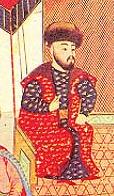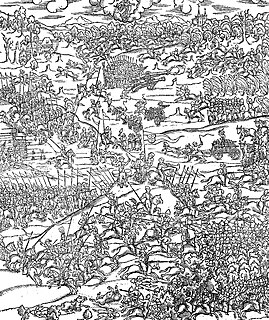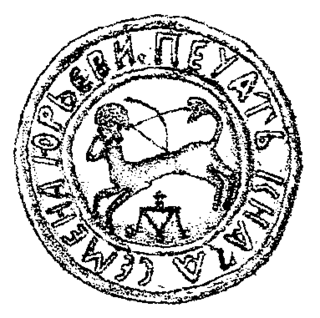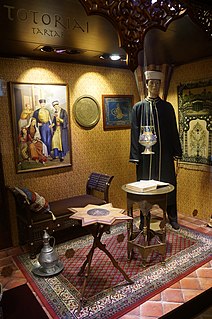Related Research Articles

The Tatars is an umbrella term for different Turkic ethnic groups bearing the name "Tatar". Initially, the ethnonym Tatar possibly referred to the Tatar confederation. That confederation was eventually incorporated into the Mongol Empire when Genghis Khan unified the various steppe tribes. Historically, the term Tatars was applied to anyone originating from the vast Northern and Central Asian landmass then known as Tartary, a term which was also conflated with the Mongol Empire itself. More recently, however, the term has come to refer more narrowly to related ethnic groups who refer to themselves as Tatars or who speak languages that are commonly referred to as Tatar.

The Golden Horde, self-designated as Ulug Ulus, lit. 'Great State' in Turkic, was originally a Mongol and later Turkicized khanate established in the 13th century and originating as the northwestern sector of the Mongol Empire. With the fragmentation of the Mongol Empire after 1259 it became a functionally separate khanate. It is also known as the Kipchak Khanate or as the Ulus of Jochi, and replaced the earlier less organized Cuman–Kipchak confederation.

The Crimean Khanate, officially the Great Horde and Desht-i Kipchak and in old European historiography and geography known as Little Tartary, was a Crimean Tatar state existing from 1441 to 1783, the longest-lived of the Turkic khanates that succeeded the empire of the Golden Horde. Established by Hacı I Giray in 1441, it was regarded as the direct heir to the Golden Horde and to Desht-i-Kipchak.

Konstanty Iwanowicz Ostrogski was a Ruthenian prince and magnate of the Grand Duchy of Lithuania and later a Grand Hetman of Lithuania from 11 September 1497 until his death.

Devlet I Giray was a Crimean Khan. His long and eventful reign saw many highly significant historical events: the fall of Kazan to Russia in 1552, the fall of the Astrakhan Khanate to Russia in 1556, the burning of Moscow at the hands of the Crimean Tatars in 1571 and the defeat of the Crimeans near Moscow in 1572. During Devlet's reign there were a number of Cossack raids on Crimea.

The Great Horde was a rump state of the Golden Horde that existed from the mid-15th century to 1502. It was centered at the core of the Golden Horde at Sarai. Both the Khanate of Astrakhan and the Khanate of Crimea broke away from the Great Horde throughout its existence, and were hostile to the Great Horde. The defeat of the forces of the Great Horde at the Great Stand on the Ugra River by Ivan III of Russia marked the end of the "Tatar yoke" over Russia.
The Russo-Crimean Wars were fought between the forces of the Tsardom of Russia and the Crimean Khanate during the 16th century over the region around the Volga River.

Meñli I Giray (1445–1515), also spelled as Mengli I Giray, was a khan of the Crimean Khanate and the sixth son of Hacı I Giray.
The Muscovite–Lithuanian Wars were a series of wars between the Grand Duchy of Lithuania, allied with the Kingdom of Poland, and the Grand Duchy of Moscow, which would later become the Tsardom of Russia. After several defeats at the hands of Ivan III and Vasily III, the Lithuanians were increasingly reliant on Polish aid, which eventually became an important factor in the creation of the Polish–Lithuanian Commonwealth. Before the first series of wars in the 15th century, the Grand Duchy of Lithuania controlled vast stretches of Eastern European land, from Kyiv to Mozhaysk, following the collapse of Kievan Rus' after the Mongol invasions. Over the course of the wars, particularly in the 16th century, the Muscovites expanded their domain westwards, taking control of many principalities.

Sahib I Giray (1501–1551) was Khan of Kazan for three years and Khan of Crimea for nineteen years. His father was the Crimean Khan Meñli I Giray. Sahib was placed on the throne of Kazan by his ambitious brother Mehmed of Crimea and driven out of Kazan by the Russians. He became Khan of Crimea with Ottoman support and was expelled by the Turks for disobedience. During his reign Crimean troops fought for the Turks and also fought in the North Caucasus. In 1532-1584, during the long reigns of Sahib I Giray, Devlet I Giray and Mehmed II Giray, Crimea was at the height of its power.

The Battle of Kletsk was a battle fought on 5 August 1506 near Kletsk, between the Grand Ducal Lithuanian army, led by Court Marshal of Lithuania Michael Glinski, and the army of the Crimean Khanate, led by Fetih I Giray and Burnaş I Giray, sons of the Khan of Crimea, Meñli I Giray. The battle was one of the first and greatest Lithuanian victories over the Tatars.
Sheikh Ahmed was the last Khan of the Great Horde, a remnant of the Golden Horde.

Ğazı II Giray was a khan of the Crimean Khanate. Born in 1554, he distinguished himself in the Ottoman–Safavid War (1578–90), gaining the trust of his Ottoman suzerains. He was appointed khan in 1588, after his homeland experienced a period of political turmoil. He failed to capture Moscow during his 1591 campaign against Tsardom of Russia, however he managed to secure a favorable peace treaty two years later. He was then summoned to support his Ottoman allies in the Long Turkish War, taking part in multiple military expeditions centered in Hungary. In late 1596, the Ottoman sultan briefly unseated Ğazı II Giray in favor of Fetih I Giray after heeding the advice of Grand Vizier Cığalazade Yusuf Sinan Pasha. He returned to power three months later, continuing his reign until his death in November 1607.

For over three centuries, the military of the Crimean Khanate and the Nogai Horde conducted slave raids primarily in lands controlled by Russia and Poland-Lithuania as well as other territories, often under the sponsorship of the Ottoman Empire.

Stanisław Piotrowicz Kiszka was a noble, diplomat and military commander from the Grand Duchy of Lithuania. He became the progenitor of the prominent Kiszka family. He was sent on frequent diplomatic missions to the Grand Duchy of Moscow and Kingdom of Poland. He attempted to negotiate peace during the Muscovite–Lithuanian Wars and supported a closer union between Poland and Lithuania. During the Second Muscovite–Lithuanian War (1500–03), he successfully defended Smolensk and became Great Hetman until Konstanty Ostrogski escaped Russian captivity in 1507. Kiszka helped to subdue the Glinski rebellion in 1508. Shortly before his death, Kiszka also became Grand Marshal of Lithuania.

Prince Semyon Yurievich of Halshany was a noble from the Olshanski family in the Grand Duchy of Lithuania.
İslâm I Giray (?–1537) was for five months 1532 Khan of the Crimean Khanate. He was preceded and followed his uncles Saadet I Girai (1524–1532) and Sahib I Giray (1532–1551). His father was Mehmed I Giray (1515–1523). Islam spent most of his life (1524–1537) trying to take the throne from his uncles. He was once Khan and twice Kalga or designated heir and co-ruler. He revolted three times, twice almost captured the khanship and once partitioned the Khanate between himself and his uncle. When not in Crimea he lived with the Nogai nomads.
Saadet I Giray (1492–1538) was Khan of the Crimean Khanate. He was pro-Ottoman and a competent ruler. He followed Ğazı I Giray (1523–24) and was followed by İslâm I Giray (1532).

Tatar population in Lithuania is an ethnic group living in the Republic of Lithuania historical lands of Lithuania. It is also considered one of the oldest ethnic minorities in Lithuania.
References
- 1 2 3 4 Gudavičius, Edvardas (1985–1988). "Olšanicos mūšis". In Zinkus, Jonas; et al. (eds.). Tarybų Lietuvos enciklopedija (in Lithuanian). Vol. 3. Vilnius: Vyriausioji enciklopedijų redakcija. p. 239. OCLC 20017802.
- 1 2 3 4 Kolodziejczyk, Dariusz (2011). The Crimean Khanate and Poland-Lithuania: International Diplomacy on the European Periphery (15th-18th Century). A Study of Peace Treaties Followed by Annotated Documents. The Ottoman Empire and its Heritage. BRILL. pp. 66–68. ISBN 9789004191907.
- ↑ Lietuvos istorijos institutas (2009-08-09). "1530 08 10 mirė Lietuvos DK didysis etmonas Konstantinas Ostrogiškis". Lietuvos Didžiosios Kunigaikštystės kalendorius (in Lithuanian). Delfi.lt. Retrieved 2015-07-16.
- ↑ Пазднякоў, В (2005). "Бітва на Альшаніцы 1527". Вялікае Княства Літоўскае (in Belarusian). Vol. 1. Беларуская Энцыклапедыя імя П. Броўкі. pp. 333–334. ISBN 985-11-0314-4.
- ↑ Howorth, Henry Hoyle (1880). History of the Mongols from the 9th to the 19th Century. Vol. 2. Longmans, Green, and Co. pp. 346, 462. OCLC 49793717.
- ↑ Bietenholz, Peter G.; Deutscher, Thomas Brian (2003). Contemporaries of Erasmus: A Biographical Register of the Renaissance and Reformation, Volumes 1-3. University of Toronto Press. p. 381. ISBN 9780802085771.